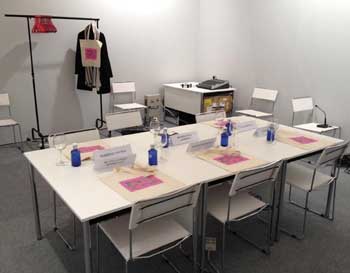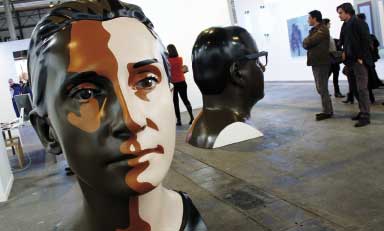
MEETING OF EXPERTS IN ARCOmadrid 2015
The latest edition of ARCOmadrid, held between February 25th and March 1st. 2015, and dedicated this year to Colombia, presented around 218 galleries, highlighting, besides the #ArcoColombia sample, the SoloProjects -reserved to latinoamerican galleries and Oppening section, a space of representation of those that do not exceed the seven years of work.
Besides the presence of prestigious specialized publications, ARCOmadrid 2015 featured an extensive program of exhibitions involving the most important collections and cultural institutions of the city.
Regardless of these various options, one of the greatest successes of the event was the interesting theoretical program promoted during the workweek: talks on core issues of collecting, presenting curators who formed the main sample and public exchange with curators and participating artists.
Also there were several professional meetings, meetings with a more intimate nature, without the presence of the public, where specialists from around the world-artists, curators, art critics, collectors, museum directors ... - generated and shared ideas around the most diverse environmental issues, many of which today are the center of controversial and impassioned debates. In these opportunities for exchange were analyzed topics such as the legacy of Latin American avant-garde, cultural development between East and West, new trends in contemporary art, with a focus on performance and gender issues, and the role of the artist and the public in their relationship with other agents of the art institution. The circumstances of the context in which the new productions are made, the changes introduced by the new technologies and social networks in the middle and the educational turn in contemporary art practices were also analyzed.
These meetings also provided special attention to the development of the biennial, emphasizing different mechanisms, ways and solutions that are used to support them. Reflection not only turned around the conceptual model, but was particularly aimed at analyzing the ethical component involving financial support of such events and the different variants that can be implemented to ensure its survival.
With the aim of exchanging experiences in this regard the meeting "Sustaining Biennials through community and business associations" took place as part of the Fair. This working session was organized and led by the executive director of Prospect New Orleans, Brooke Davis Anderson, who gathered around the theme representatives of different biennial, most of them of recent creation- presented on the international art scene as an alternative to the economic and organizational model of the Venice Biennale.
In addition to the representation of the Havana Biennial-event which highlighted as a benchmark of some of the participants in the professional appointment, Natalia Bonilla, director of the Biaci Foundation (International Art Biennale Cartagena de Indias ); Sylvie Fortin, CEO of Montreal Biennale; Marieke van Hal, director of the Biennial Fundation, and Marcelo Rezende, director of the 3rd. Biennial of Bahia attended the meeting.

Notable is the successful selection of the attendees projects, with more than one contact point and much to contribute to each other. Clearly these biennial share their alternative condition, especially when occurring in cities that are not recognized as international art centers or the institutional infrastructure does not meet the expectations of the new contemporary productions that take place in them. Then they are events that pay particular attention to the potential of the contexts in which they operate, responding accordingly to their needs, meeting their needs and / or adjusting the characteristics that define them. In this regard, it is worth noting the experience of the first edition of the Biennial of Cartagena de Indias, where in addition to the works presented took on special prominence urban spaces of historical character and heritage used as venues for exhibitions. These ideas are a sign of the intentions of such events, which emphasize local values of their contexts, using artistic practices as a means and not an end. In the same rope the initiative developed by the Biennial of Bahia highlights, whose program was proposed to bring back important references regarding the history of regional and international art that had special meaning for the people of the city.
These similarities, barely sketched, make events like these, which occur in very specific circumstances and in very different latitudes also share their interests and broader aspirations, their problems and concerns. That was demonstrated at the meeting, where conflicts surfaced, for example, with the alleged contradictions between the public to which a Biennial of this nature should be addressed: local, specialized, sponsors, artists, etc. How to reconcile the interests of these different audiences to ensure the survival of the biennial? How to make flexible the model to ensure continuity of the biennial? How to financially support such events whose goals go away, increasingly, of the principles underlying the classic model introduced by Venice?
What is the fate of such events? What are the challenges imposed? How the works presented in them define the character of the same? How to ensure that the efforts of the organizers do not result in a temporary event, but that result in the production of cultural values and historical references? These are just some of the questions that were raised at that meeting and the answers, often screened by anecdotes, ingenious ideas, few conventional solutions, etc., rather than give absolute solution to these issues, generated an even more satisfying certainty: biennial still have much to tell.
Perhaps the most significant of all is the fact that this fruitful exchange of ideas occurred just in the heat of one of the most important art fairs in the world and at the initiative of the organizers. Maybe it's a way to deter us from once of those schemes that demonize the economic, a warning that the world has changed and art biennials have evolved into other forms of representation and art fairs as well. In light of these considerations, ARCOmadrid was presented, beyond economic transactions and the sale of symbolic objects, as an excellent space for interaction, useful for professional, conceptual and emotional connection tool, a place to meet and be recognized in other projects and initiatives.
Much has been speculated in recent years about the crisis of art and incompetence of the various agents of the institution to welcome and represent the most innovative demonstrations that in this field occur.
Some insist in placing some responsibility on the shoulders of the market, erected in catalyst legitimating processes not always convincing but without doubt effective-, which have led to the much-bandied bubble effect. In this context, which roles of each of the segments that make up the system are not yet defined, there has been a proliferation of fairs, international events around which has begun to turn, as well, the contemporary art world.
While these events weighted commercial interests above the other, it is valid to note that at the same time they generate other kinds of exchanges, including in their different dynamics bodies, private or institutional, that value their shares, legitimizing them. Therefore, it is increasingly common, besides the main exhibition, to find a set of collateral exhibitions and theoretical activities that have little or nothing to do with fair project, but that likewise attract artists, critics, collectors, curators and interested in general.
Related Publications

How Harumi Yamaguchi invented the modern woman in Japan
March 16, 2022
Giovanni Duarte and an orchestra capable of everything
August 26, 2020











